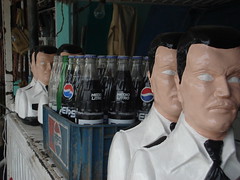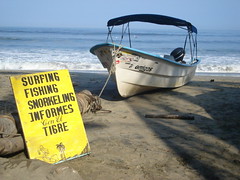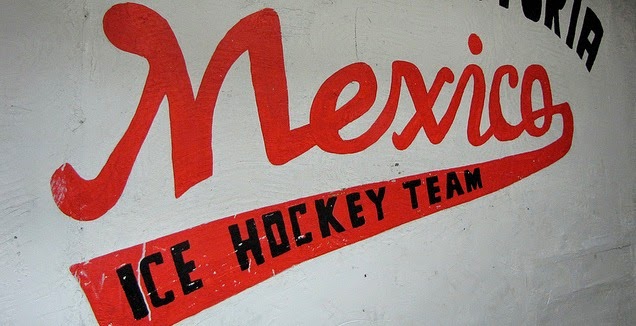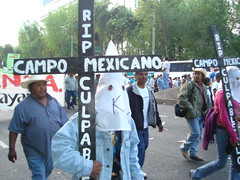
By David Agren
The News
Six months ago, Cesar Moreno was flat broke. His paycheck was already three days overdue. Desperate and hungry, he visited a sidewalk shrine in the Colonia Doctores dedicated to
Jesús Malverde, the patron saint of narcotics traffickers, where he asked for a miracle. While walking home, he stumbled upon a 100-peso note.
"It wasn't much ... but it was something," he recalled while clutching a green candle during a monthly celebration at a Mexico City
Malverde shrine.
Today, Moreno regularly prays to the figure. Dressed in western clothing with pale skin, a full mustache and a thick shock of dark hair,
Malverde is a pseudo saint beloved by some of Mexico's most unsavory characters.
Moreno is one of a growing number of believers in
Malverde, a stagecoach bandit, who supposedly carried out his misdeeds in the hills of Sinaloa a century ago. In spite of his notorious handle – the patron saint of narcotics traffickers – or perhaps even because of it,
Malverde's appeal has spread in recent years from the narco heartland of northwestern Mexico and spilled into the nation's capital, immigrant communities in the United States.
The surge in
Malverde's prominence coincides with an escalation in drug-related violence in Mexico, which claimed more than 2,500 lives during 2007. Since taking office, President Felipe Calderon has sent more than 30,000 federal troops and policemen to various states throughout the country to crack down on organized crime.
Experts say
Malverde's rise to prominence is no coincidence, directly attributing
Malverde's appeal to the growing influence of the drug business and the culture that surrounds it.
"The phenomenon of
Malverde has been promoted in other parts of Mexico thanks to narcotics traffickers. There's no other explanation for this," said César López, a history professor at the University of Guadalajara.
"Narcotics trafficking is a growing industry in this country and the saint's popularity has been growing along with it," he said.
In a country where drug culture has spawned celebrities, perhaps
Malverde's popularity really isn't that surprising. Sandra Avila Beltran, otherwise known as "La Reina del Pacifico," was known to dine in some of Mexico City's swankiest restaurants. Before her 2007 arrest – the cops tracked her down through her usual eating haunts – her rise to power in the male-dominated world of drug-trafficking had created a cult of personality embraced by feminists around the country.
Narcocorridos, a subgenre of Nortena music featuring lyrics about kidnappings, drug deals and local narco bosses, are sold in markets throughout the nation's most drug-plagued states. Various YouTube sites are dedicated to drug-traffickers like "Chapo" Guzman. Just as gang culture is celebrated by some in the United States, narcos are increasingly admired by many in Mexico.
But the
Malverde phenomenon currently appears to be in a league of its own.
For one, it has become big business. Guadalajara brewery Cervecería Minerva recently launched a pilsner with the label, "Malverde," and a chain of "kitsch" bars in the capital region has adopted the unofficial saint's name. (The Condesa branch features one of his busts inside.)
Malverde's entered the art world too: a
Malverde-inspired piece won acclaim at a recent national exhibition. Even the Mexican military has placed a
Malverde bust in its Mexico City museum.
THE FAITHFUL
Most
Malverde followers insist he isn't just for narcos. Alberto Jiménez, a vendor in the Mercado Sonora – a hub for witchcraft-related items, dubious miracle cures and folk saints unrecognized by the Catholic Church - said
Malverde images began appearing at the market about five years ago and became popular with people going through rough spells.
"
Jesús Malverde is who you turn to when things are tough," the market veteran explained. Jiménez, like many
Malverde followers, acknowledged the narco saint's murky background as a bandit, who, like Robin Hood, reputedly stole from the rich and gave to the poor. And while most adherents also identify themselves as Catholics and profess a belief in the Virgin of Guadalupe, few express misgivings about
Malverde's unrecognized status as a saint.
"[The Catholic Church] doesn't like him," said Sabino Martínez, a musician playing guitar at the shrine, who referred to
Malverde as "a saint for the poor.
"They won't make a saint out of someone who robbed to help the poor."
Thief or not, no solid proof of
Malverde's existence has ever surfaced, although his image resembles famed actor and Sinaloa native Pedro Infante.
THE MAN
MALVERDE
The story has it that
Malverde was born
JesúsJuárez in 1870 and was hanged from a tree on May 3, 1909. His legend, however, lives on, especially in Sinaloa, a western state with a long coastline, some of Mexico's most abundant agricultural regions and a rugged sierra. Sinaloa officially lives for agriculture and the state license plate boasts an image of a tomato. But with the advent of marijuana and other smuggling activities,
Malverde's fame grew throughout the state.
"He might not have existed before, but he sure exists now," said James Griffith, a retired University of Arizona professor and expert on Mexican folk saints.
A shrine built in
Malverde's honor was moved in the 1970s, but only in order to accommodate the construction of a new state legislature. Maps provided by the Culicacán tourism board give directions to the new shrine. Outside, vendors hawk
Malverde trinkets – wallets, key chains and pendants. Bands milling around the exterior play narcocorridas.
Inside, people wait patiently to enter a dimly-lit central room adorned with wood paneling and red carpeting that houses a venerated
Malverde bust, which most followers kneel in front of and gingerly touch with an outstretched hand.
The narco saint's adherents fail to fit any one stereotype, according to an elderly woman named Doña Tere, a long-time vendor, peddling
Malverde paraphernalia-like busts, necklaces and belt-buckles in a corner.
"All sorts of people come here ... famous people, important people, poor people [and] rich people," she said, pulling out a stack of photos featuring banda musicians and famous actors who had paid a visit.
Some followers leave Polaroid photos taken at the shrine. Others leave notes. Consider one from Daniel, Alejandro and Miguel. "
Jesús Malverde, help us with our objective and care for us on this road we have chosen and permit us to return to give thanks for our fortune and health," wrote the trio.
Those returning with cash sometimes pay for plaques, which speak of "favors received" and "success in business." Visitors also leave behind donations that fund the shrine, charity projects like burials for those who lack money and an annual party on May 3. At the bash, bands play narcocorridos and the attendees are showered with giveaways, including toys and household items.
A similar, but lower-key scene plays out at the Colonia Doctores shrine on the third day of each month, when some 30 to 70 adherents gather. At dusk, a life-size statue of
Malverde – with a noose around its neck and dollar bill tucked in its shirt pocket – is loaded into a pickup truck for a spin around Doctores, a tough barrio known for chop shops and Arena Mexico, home of the Lucha Libre.
María Alicia Pulido Sánchez erected the shrine last fall after her teenage son recovered from an automobile accident more quickly than expected. She turned to
Malverde at the recommendation of a friend. But with growing commercialization, it's not only the disenfranchised who are turning to
Malverde. Fresas, or snobs, are increasingly indulging in the naco – the tacky or low class, side of Mexico's popular culture.
At Bar
Malverde in Mexico City's hip Colonia Condesa the house specialty is an 80-peso Martini
Malverde, a mix of vodka, melon liqueur, Cointreau and lime juice.
Apparently ignoring narco-saint
Malverde's bust right next to him on the bar, bartender Luis Mondragón insisted the name "isn't about glorifying narcos."
Cervecería Minerva, which leveraged the narco saint's name, branding its newest pilsner "
Malverde," claims that sales are doing well.
Malverde was mostly unknown outside of Northwestern Mexico a decade ago, according to sales manager Alejandro Orozco, but now he's "known by everyone." He attributed
Malverde's popularity to the national trend of embracing "kitschy" things rather than the tendency to glorify criminals.
But he did compare his brewery's feting of
Malverde to marketing efforts north of the border that have leveraged the notoriety of gangster Al Capone and other nefarious characters.
"[
Malverde] isn't just liked by narcos, but by honorable people too," he said.



